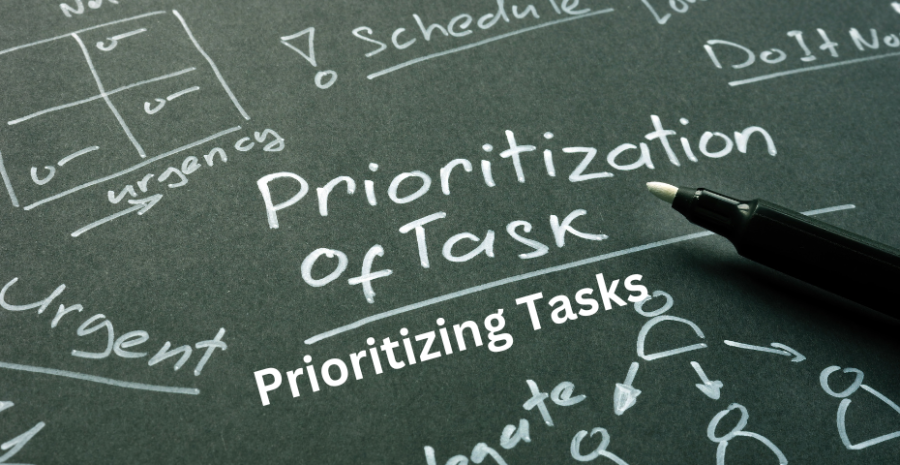
The 20/80 Rule for Entrepreneurs: Mastering Efficiency and Success

The 20/80 Rule, also known as the Pareto Principle, is a powerful concept that can significantly impact the efficiency and success of entrepreneurs. Named after Italian economist Vilfredo Pareto, who observed that 80% of Italy's land was owned by 20% of the population, this principle has since been applied to various aspects of business and productivity.
For entrepreneurs looking to optimize their efforts and achieve greater success, understanding and implementing the 20/80 Rule can be transformative. Here’s a comprehensive guide on how to leverage this principle effectively:

The 20/80 Rule suggests that 20% of your activities will account for 80% of your results. This means that a small portion of your efforts can lead to the majority of your achievements. Identifying and focusing on these high-impact activities can enhance productivity and business outcomes.
Identifying the critical 20% requires a thorough analysis of your business activities. This might involve examining sales data, customer feedback, or marketing performance. By pinpointing which actions, products, or clients are most beneficial, you can prioritize these high-value elements. This focus not only drives better results but also helps in managing time and resources more efficiently.
Applying the 20/80 Rule involves a shift in mindset from trying to do everything to focusing on what matters most. Entrepreneurs need to cultivate the ability to say no to low-impact tasks that consume time without contributing significantly to their goals. This disciplined approach allows for a greater concentration on activities that propel the business forward, leading to sustained growth and success.
The 20/80 Rule encourages continuous evaluation and adjustment. As market conditions and business dynamics change, the key activities driving success may also evolve. Regularly reassessing which 20% of efforts are most effective ensures that entrepreneurs remain agile and responsive to new opportunities and challenges, maintaining their competitive edge.
Ultimately, understanding and implementing the 20/80 Rule can transform an entrepreneur's approach to business. It fosters a culture of efficiency, where the focus is on impactful actions rather than exhaustive effort. By leveraging this principle, entrepreneurs can achieve more with less, driving substantial growth and achieving long-term success.
To apply the 20/80 Rule, entrepreneurs must first identify the 20% of activities that generate the most significant results. This could involve analyzing sales data to determine which products or services are most profitable, identifying the most effective marketing strategies, or recognizing key clients who contribute the most to revenue.
Identifying key activities is a crucial step in leveraging the 20/80 Rule effectively. Entrepreneurs must start by analyzing their business operations to determine which tasks yield the highest returns. This involves a thorough examination of sales data, customer interactions, and performance metrics to pinpoint the 20% of activities that generate 80% of the results. By understanding which actions drive revenue, growth, and customer satisfaction, entrepreneurs can strategically focus their efforts where they matter most.
To identify these key activities, entrepreneurs can use various tools and techniques such as SWOT analysis, Pareto charts, and customer feedback surveys. These methods help in highlighting the most impactful products, services, and processes. It's essential to look at different aspects of the business, including marketing campaigns, sales strategies, and operational efficiencies, to find the areas with the highest potential for impact.
Once the high-impact activities are identified, it’s important to prioritize them in day-to-day operations. This means dedicating more time, resources, and attention to these critical tasks. Entrepreneurs should create a focused plan that allocates sufficient resources to these areas while minimizing time spent on less impactful activities. This targeted approach ensures that the business’s energy is directed towards the actions that will drive the most significant results.
Identifying key activities often involves collaboration and input from various team members. Employees who are on the front lines interacting with customers or managing daily operations can provide valuable insights into which tasks are most beneficial. Engaging the team in this process not only helps in accurately identifying high-impact activities but also fosters a culture of efficiency and continuous improvement.
Entrepreneurs should also be flexible and willing to adjust their strategies as new data and insights emerge. Regularly reviewing and reassessing key activities ensures that the business stays aligned with its goals and adapts to changing market conditions. This dynamic approach helps in maintaining a focus on what truly matters, driving sustained growth and success.
In conclusion, identifying key activities is about recognizing and focusing on the few tasks that drive the majority of results. This targeted approach, backed by data and team collaboration, allows entrepreneurs to optimize their efforts and resources effectively. By continually refining and prioritizing these high-impact activities, businesses can achieve greater efficiency, growth, and long-term success.

Once the high-impact activities are identified, prioritize them in your daily, weekly, and monthly plans. Allocate more time and resources to these tasks to ensure they receive the attention they deserve. By doing so, you maximize the efficiency of your efforts and increase the likelihood of achieving your business goals.
Prioritizing tasks is essential for entrepreneurs aiming to implement the 20/80 Rule effectively. Once the key activities that drive the most significant results are identified, the next step is to prioritize them in your daily operations. This involves organizing your schedule and workflow to ensure that the high-impact tasks receive the most attention and resources. By doing so, you can ensure that your efforts are focused on the areas that will bring the greatest returns, enhancing overall productivity and success.
A practical way to prioritize tasks is to create a structured plan, such as a daily or weekly to-do list that highlights critical activities. Tools like Eisenhower Matrix, which categorizes tasks based on their urgency and importance, can help in distinguishing between high-priority and low-priority tasks. Allocating time blocks for these key activities ensures they are completed efficiently, without being overshadowed by less critical tasks.
In addition, setting clear goals and deadlines for high-priority tasks can enhance focus and motivation. Breaking down these tasks into smaller, manageable steps can make them less overwhelming and easier to tackle. Entrepreneurs should consistently review and adjust their priorities to adapt to new challenges and opportunities, ensuring that they remain aligned with their overall business objectives.
Another important aspect of prioritizing tasks is the ability to delegate or outsource less impactful activities. By entrusting routine or administrative tasks to others, entrepreneurs can free up more of their own time to concentrate on strategic initiatives. This not only improves efficiency but also empowers team members by involving them in the business’s operational processes.
Entrepreneurs should also leverage technology and automation to streamline and prioritize tasks. Project management tools, calendar apps, and productivity software can help in organizing and tracking progress on high-impact activities. These tools provide a clear overview of what needs to be done, allowing for better time management and ensuring that important tasks are not neglected.
Ultimately, prioritizing tasks requires a disciplined approach and a commitment to focusing on what truly matters. By consistently aligning efforts with the 20/80 Rule, entrepreneurs can maximize their impact, achieve their goals more efficiently, and drive sustainable growth. This strategic focus on high-priority tasks is key to transforming effort into tangible success in the entrepreneurial journey.
For the remaining 80% of activities that yield only 20% of results, consider delegating or outsourcing them. This could include administrative tasks, minor customer service inquiries, or routine maintenance tasks. Delegation allows entrepreneurs to focus their energy on strategic activities that drive growth and profitability.
Delegating and outsourcing are vital strategies for entrepreneurs aiming to optimize their time and resources according to the 20/80 Rule. Recognizing that 80% of tasks only contribute 20% to the results, entrepreneurs can significantly boost efficiency by offloading these lower-impact activities. Delegation involves assigning tasks to employees within the organization, while outsourcing involves contracting third-party providers to handle specific functions. Both approaches free up valuable time for entrepreneurs to focus on high-priority activities that drive substantial business growth.
Effective delegation starts with identifying tasks that others can perform competently. Entrepreneurs should assess their team’s skills and strengths to match tasks with the right individuals. Clear communication of expectations and deadlines is crucial to ensure that delegated tasks are completed successfully. Regular check-ins and feedback help maintain accountability and quality, while empowering employees to take ownership of their responsibilities.
Outsourcing, on the other hand, is ideal for specialized tasks that require expertise outside the core competencies of the business. Functions such as accounting, IT support, and digital marketing can be outsourced to professionals who can deliver high-quality results efficiently. This not only saves time but often reduces costs associated with hiring and training in-house staff for these specialized roles.
Both delegating and outsourcing require trust and a willingness to relinquish control over certain aspects of the business. Entrepreneurs need to build strong relationships with their team members and external providers to ensure a seamless workflow. Setting clear objectives and performance metrics helps in monitoring progress and achieving desired outcomes. This strategic approach enables entrepreneurs to leverage external expertise and internal talent effectively.
Moreover, technology can play a significant role in facilitating delegation and outsourcing. Project management tools, communication platforms, and cloud-based solutions allow for smooth coordination and collaboration, regardless of geographical locations. These tools provide real-time updates and streamline processes, making it easier to manage tasks that are handled by different parties.
In conclusion, delegating and outsourcing are essential for entrepreneurs seeking to apply the 20/80 Rule and optimize their efficiency. By focusing on high-impact activities and offloading less critical tasks, entrepreneurs can drive growth and innovation. Trusting and empowering others to handle specific functions not only enhances productivity but also fosters a collaborative and dynamic business environment.

Implementing the 20/80 Rule can help streamline operations by eliminating or reducing low-value activities. This can lead to a leaner, more efficient business model. Regularly review your processes and workflows to identify areas where time and resources are being wasted and make necessary adjustments.
Streamlining operations is a key aspect of applying the 20/80 Rule for entrepreneurs, aiming to enhance efficiency by focusing on high-impact activities. The first step in streamlining is to analyze existing processes and identify bottlenecks or redundant steps that do not add significant value. This involves a thorough review of workflows, procedures, and resource allocation to determine areas where improvements can be made. By eliminating wasteful practices and optimizing essential processes, businesses can reduce costs and improve overall productivity.
Implementing automation is a powerful way to streamline operations. Automation tools can handle repetitive tasks such as data entry, customer inquiries, and inventory management, freeing up time for more strategic activities. Investing in modern technology solutions, such as customer relationship management (CRM) systems or enterprise resource planning (ERP) software, can significantly enhance operational efficiency and accuracy.
Another effective strategy is to adopt lean management principles, which focus on maximizing value while minimizing waste. Lean practices, such as continuous improvement (Kaizen) and just-in-time inventory, help businesses stay agile and responsive to changes in demand. By regularly reviewing and refining processes, entrepreneurs can ensure that their operations remain efficient and aligned with business goals.
Standardizing processes is also crucial for streamlining operations. Developing clear, documented procedures for routine tasks ensures consistency and quality across the organization. This standardization not only improves efficiency but also makes it easier to train new employees and scale operations as the business grows. Entrepreneurs should create detailed manuals and training programs to maintain high standards.
Effective communication and collaboration are essential components of streamlined operations. Entrepreneurs should foster a culture of open communication where team members can share ideas and feedback on improving processes. Utilizing collaboration tools such as project management software and team messaging apps can facilitate better coordination and information sharing, leading to smoother operations and quicker problem-solving.
In conclusion, streamlining operations involves a combination of process analysis, automation, lean management, standardization, and enhanced communication. By focusing on these areas, entrepreneurs can eliminate inefficiencies and ensure that their efforts are directed toward high-impact activities. This strategic approach not only boosts productivity but also positions the business for sustainable growth and success.
The 20/80 Rule often applies to customer relationships, where 20% of customers generate 80% of revenue. Focus on nurturing these key relationships through personalized service, loyalty programs, and targeted marketing efforts. Satisfied top customers can become brand advocates and drive further business growth.
Enhancing customer relationships is a vital application of the 20/80 Rule for entrepreneurs, as a small portion of customers often drive the majority of revenue. To maximize these relationships, entrepreneurs should focus on providing exceptional customer service and personalized experiences. Understanding the specific needs and preferences of key customers allows businesses to tailor their offerings and interactions, fostering loyalty and long-term engagement. By prioritizing high-value customers, entrepreneurs can ensure these clients feel valued and appreciated.
Building strong customer relationships involves consistent and effective communication. Regularly reaching out through personalized emails, phone calls, or face-to-face meetings helps maintain a connection and demonstrates commitment to their satisfaction. Utilizing customer relationship management (CRM) systems can aid in tracking interactions and managing customer data, allowing for more targeted and meaningful communication.
Offering exclusive benefits and rewards to top customers can further strengthen these relationships. Loyalty programs, special discounts, and early access to new products or services can make key customers feel special and valued. This not only encourages repeat business but also enhances customer retention, which is often more cost-effective than acquiring new customers.
Gathering and acting on customer feedback is crucial for improving relationships. Entrepreneurs should actively seek input through surveys, reviews, and direct conversations to understand their customers' experiences and expectations. Responding to feedback promptly and making necessary improvements shows customers that their opinions matter, thereby increasing trust and loyalty.
Providing consistent and reliable support is another essential aspect of enhancing customer relationships. Quick and effective resolution of issues or concerns can significantly impact customer satisfaction. Implementing robust customer support systems, including live chat, helpdesks, and self-service options, ensures that customers can easily access assistance whenever needed.
In conclusion, enhancing customer relationships by focusing on high-impact activities can lead to greater customer loyalty and increased revenue. By delivering personalized experiences, maintaining open communication, offering exclusive benefits, gathering feedback, and providing exceptional support, entrepreneurs can build strong, lasting relationships with their most valuable customers. This strategic focus not only drives repeat business but also creates a base of loyal customers who can become advocates for the brand.

In marketing, 20% of your campaigns may produce 80% of your leads and sales. Analyze your marketing efforts to identify which channels, messages, and strategies yield the best results. Invest more in these high-performing areas and cut back on less effective ones to maximize your return on investment.
Optimizing marketing strategies is essential for entrepreneurs looking to leverage the 20/80 Rule to achieve maximum impact. This process begins with identifying the 20% of marketing efforts that generate 80% of the results. By analyzing data from various campaigns, entrepreneurs can determine which channels, messages, and tactics yield the highest returns. Focusing on these high-impact areas allows for more efficient use of marketing budgets and resources, driving better overall performance.
One of the key steps in optimizing marketing strategies is to segment the target audience effectively. Understanding the demographics, behaviors, and preferences of different customer segments enables more precise and relevant messaging. Tailoring marketing efforts to specific segments increases engagement and conversion rates, making campaigns more effective and efficient. Utilizing customer data and analytics tools can help in creating detailed customer profiles and understanding their journey.
Content marketing is another crucial area to optimize. By creating high-quality, valuable content that addresses the needs and interests of the target audience, entrepreneurs can attract and retain customers more effectively. Regularly updating and repurposing content can also enhance its reach and impact. Focusing on SEO and keyword optimization ensures that content is discoverable by potential customers, driving organic traffic and leads.
Leveraging social media platforms strategically can significantly enhance marketing effectiveness. Entrepreneurs should identify the platforms where their target audience is most active and focus their efforts there. Creating engaging and shareable content, running targeted ads, and interacting with followers can build brand awareness and loyalty. Utilizing analytics tools to track social media performance helps in refining strategies and maximizing ROI.
Regularly testing and experimenting with different marketing tactics is essential for optimization. A/B testing, for example, allows entrepreneurs to compare different versions of ads, emails, or landing pages to see which performs better. Continuous experimentation and data analysis help in identifying the most effective strategies and eliminating those that are less successful. This iterative approach ensures that marketing efforts remain dynamic and responsive to changing market conditions.
In conclusion, optimizing marketing strategies involves focusing on high-impact activities, effectively segmenting the audience, creating valuable content, leveraging social media, and continuously testing tactics. By applying the 20/80 Rule to their marketing efforts, entrepreneurs can achieve greater efficiency and effectiveness, driving higher returns on their marketing investments. This strategic approach not only enhances brand presence but also contributes to sustainable business growth.
The 20/80 Rule can also enhance personal productivity by improving time management. Identify the tasks and activities that significantly impact your business and prioritize them in your schedule. Use tools like time blocking and to-do lists to stay focused on high-priority tasks.
Improving time management is crucial for entrepreneurs aiming to maximize productivity and implement the 20/80 Rule effectively. Effective time management begins with identifying the high-priority tasks that drive the most significant results and scheduling them into the daily routine. Entrepreneurs should allocate specific time blocks for these critical activities, ensuring they are given undivided attention without distractions. This focused approach helps in accomplishing more in less time and increases overall efficiency.
Utilizing tools and techniques like the Pomodoro Technique, time blocking, and to-do lists can greatly enhance time management. These methods help break the day into manageable segments, making it easier to concentrate on one task at a time. Additionally, digital tools such as project management software and calendar apps can help keep track of deadlines, appointments, and important tasks, ensuring nothing falls through the cracks.
Setting clear goals and priorities is essential for effective time management. Entrepreneurs should define their most important objectives and break them down into actionable steps. By setting SMART (Specific, Measurable, Achievable, Relevant, Time-bound) goals, they can create a clear roadmap for what needs to be accomplished and by when. This not only helps in staying organized but also keeps the focus on tasks that contribute the most to business success.
Delegating and outsourcing tasks is another vital component of improving time management. Entrepreneurs often try to handle everything themselves, which can lead to burnout and inefficiency. By entrusting less critical tasks to team members or external providers, they can free up valuable time to focus on strategic initiatives that require their expertise. Effective delegation also empowers the team, fostering a collaborative and productive work environment.
Regularly reviewing and adjusting schedules is necessary to adapt to changing priorities and demands. Entrepreneurs should periodically assess how their time is spent and make adjustments as needed. This might involve shifting time blocks, rescheduling less critical tasks, or even eliminating activities that no longer serve their goals. Continuous evaluation and flexibility ensure that time management practices remain aligned with business objectives.
In conclusion, improving time management involves a combination of prioritizing high-impact tasks, utilizing effective tools and techniques, setting clear goals, delegating appropriately, and regularly reviewing schedules. By mastering these elements, entrepreneurs can optimize their productivity, reduce stress, and focus on what truly matters. This strategic approach not only enhances individual efficiency but also contributes to the overall growth and success of the business.
.png)
Regularly measure and analyze the results of your efforts to ensure you are focusing on the right activities. Use key performance indicators (KPIs) and other metrics to track progress and make data-driven decisions. This ongoing analysis helps refine your approach and ensures you remain aligned with your business goals.
Measuring and analyzing results is essential for entrepreneurs seeking to maximize the benefits of the 20/80 Rule. By regularly tracking key performance indicators (KPIs) and other relevant metrics, entrepreneurs can identify which activities are yielding the most significant outcomes. This data-driven approach ensures that efforts are focused on high-impact tasks that drive growth and success. Tools such as analytics software, financial reports, and customer feedback systems provide valuable insights into business performance, highlighting areas of strength and opportunities for improvement.
Analyzing results involves looking beyond surface-level data to understand underlying trends and patterns. Entrepreneurs should delve into detailed reports to uncover insights about sales performance, marketing effectiveness, customer behavior, and operational efficiency. This thorough examination helps pinpoint which 20% of activities are contributing to 80% of the results, allowing for more informed decision-making and strategic planning.
Regularly reviewing these metrics enables entrepreneurs to make necessary adjustments to their strategies and operations. By identifying underperforming areas, they can reallocate resources to more effective activities, enhancing overall efficiency. This continuous cycle of measurement and analysis fosters a culture of improvement and adaptability, ensuring that the business remains agile and competitive in a dynamic market.
Moreover, setting specific, measurable goals based on analyzed data can drive targeted efforts and accountability. Entrepreneurs should establish benchmarks and performance targets to measure progress over time. This not only provides a clear direction for the business but also motivates the team by highlighting achievements and areas that need attention.
Engaging the team in the measurement and analysis process can also yield valuable insights and foster a collaborative environment. Employees can offer perspectives from their specific roles, contributing to a more comprehensive understanding of the business’s performance. This collective effort ensures that all aspects of the business are considered, leading to more robust and effective strategies.
In conclusion, measuring and analyzing results is a continuous and integral part of applying the 20/80 Rule. By leveraging data to understand what works and what doesn’t, entrepreneurs can optimize their efforts, make informed decisions, and drive sustainable growth. This strategic focus on high-impact activities ensures that resources are used efficiently, maximizing the overall success and profitability of the business.
The application of the 20/80 Rule is an ongoing process that requires continuous improvement. Regularly reassess your activities, priorities, and strategies to adapt to changing market conditions and business needs. Stay agile and be willing to pivot when necessary to maintain a focus on high-impact activities.
Continuous improvement is the cornerstone of success for entrepreneurs applying the 20/80 Rule. Embracing a mindset of continual refinement allows businesses to stay responsive to changing market dynamics and customer preferences. By regularly assessing processes, strategies, and outcomes, entrepreneurs can identify areas for enhancement and innovation. This iterative approach fosters a culture of learning and adaptation, where every iteration builds upon previous successes and lessons learned from challenges.
Entrepreneurs should encourage feedback from customers, employees, and stakeholders to gain diverse perspectives on areas needing improvement. This inclusive approach not only promotes innovation but also strengthens relationships with stakeholders by demonstrating a commitment to excellence. Implementing feedback loops and soliciting suggestions for improvement empowers the team and fosters a sense of ownership in driving positive change.
Moreover, leveraging technology and automation can streamline processes and facilitate continuous improvement efforts. Monitoring tools, analytics software, and project management platforms provide real-time insights into performance metrics, enabling proactive adjustments and optimizations. By integrating technology into operations, entrepreneurs can enhance efficiency and scalability while maintaining a focus on high-impact activities.
Setting specific improvement goals and milestones is essential for tracking progress and maintaining momentum. Entrepreneurs should establish clear objectives that align with their long-term vision, breaking them down into manageable tasks and timelines. Regularly reviewing progress against these goals ensures accountability and facilitates course corrections when necessary, keeping the business on track towards achieving its objectives.
Lastly, fostering a culture of continuous improvement requires leadership commitment and active participation. Entrepreneurs should lead by example, demonstrating openness to feedback, willingness to experiment, and dedication to ongoing learning. By nurturing a culture where innovation and improvement are celebrated, entrepreneurs can inspire creativity and resilience within their team, driving sustained growth and competitive advantage.
Continuous improvement is not just a strategy but a mindset that fuels entrepreneurial success. By embracing change, learning from experiences, and adapting to evolving circumstances, entrepreneurs can optimize their operations, enhance customer satisfaction, and achieve long-term profitability. This commitment to continuous improvement ensures that businesses remain agile, resilient, and well-positioned for future success in dynamic markets.
The 20/80 Rule is a valuable tool for entrepreneurs seeking to optimize their efforts and achieve greater success. By identifying and focusing on the activities that generate the most significant results, entrepreneurs can enhance productivity, streamline operations, and drive business growth.
Embrace the 20/80 Rule as a guiding principle in your entrepreneurial journey and watch your efficiency and success soar.

About: Andries vanTonder (65)
45 years selfemployed
He is a Serial Entrepreneur, an Enthusiastic supporter of Blockchain Technology and a Cryptocurrency Investor
Find me: Markethive Profile Page | My Twitter Account | My Instagram Acount | and my Facebook Profile.
